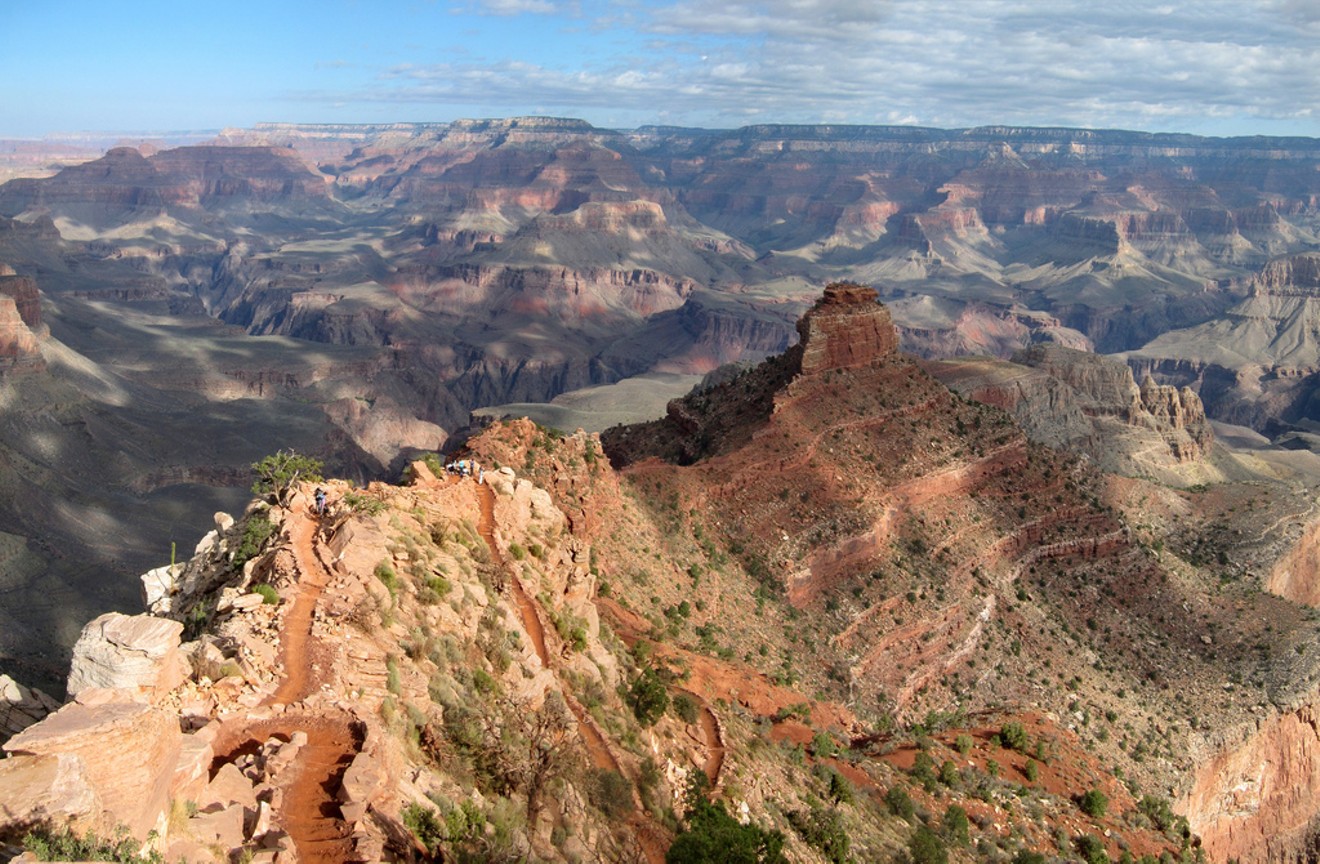Since then, I’ve descended the Canyon many times and it’s lived up to my every expectation. I am both tiny and larger than life in it. Its silence and unparalleled beauty hit my “reset” button, while the long, steep hike pushes my limits.
On my sixth
Stay at the Rim
The rooms along the South Rim are sometimes hard to book, but reserve one if you can. This will allow you to arrive the night before your hike and get an early morning start the day of your trek. Plus, the South Rim is chock-full of deer, elk, antelope, turkeys, and other wildlife that will change your life.
Drive Past Tusayan
The restaurants in Tusayan, the town right outside of the South Rim of the park, are overpriced and not very good, whereas pretty much any restaurant, cafeteria, or food court within the park is delicious, reasonably priced, and has gluten-free and vegetarian options.

Although a faster route to the bottom of the Canyon, South Kaibab Trail is filled with steep plunging ridgeline switchbacks like this. Water and emergency phones are not available on this trail, and rangers and shady areas are rare.
NPS Photo by Michael Quinn/Flickr Creative Commons
I used to snub tourist darling Bright Angel Trail for South Kaibab Trail because the latter is less congested and two and a half miles shorter. Until the time I got very sick on it and lost massive amounts of bodily fluids without enough water to make up for the dehydration it caused. Concerned hikers stopped to help, but also had "just enough" water.
Too weak to walk five miles back up to the South Rim, my options were a potential $10,000 helicopter ride (after a four-hour wait for someone to hike up to fetch it), or to proceed to Phantom Ranch, where there would be water and our pre-arranged meals and lodging. Luckily, my hiking partner (and now fiancé) fed me all his water, a risky move. This, paired with electrolyte tablets, saved my life. Don't tempt fate at the Grand Canyon — always use Bright Angel Trail, which has safety nets for life's surprises.

Grand Canyon's Bright Angel Trail leads to the Colorado River, but there's no need to trek its 10 miles to get to the bottom. At the edge of the valley in this photo, you can see the lush trees of Indian Garden. To its front left is a trail that crosses the middle of a mesa called Tonto Platform. Hike to the end of this trail to see the Colorado River and avoid a much longer hike to the bottom.
NPS Photo by Michael Quinn/Flickr Creative Commons
Bright Angel Trail is a 10-mile trek to the bottom that offers drinking water, emergency lines, park and volunteer rangers, and lots to see along the way.
Between the South Rim of the Grand Canyon and its sorta-half-way point, Indian Garden, there are three seasonal water stations and two bathrooms — more than any of the other maintained trails. Like a water cooler, they breed interaction, so you can chat it up with visitors from all over the world. After Indian Garden, drinking water is not available for another five dry miles, so
Park rangers and volunteer rangers typically monitor the first few miles down from the South Rim, although I’ve seen them as far as six miles in. Park guides claim they “randomly patrol” South Kaibab Trail, which sounds like code for "pretty much never."
Every time I hike Bright Angel Trail, I discover something new. With a creek that runs along parts of it, old-school phone lines, butterflies, wildflowers, and Indian Garden, a lush stop four miles down the rim to sit and eat lunch, it is arguably the Canyon’s most beautiful path.
There’s a spot near Indian Garden where the trail crosses a shallow creek. Be sure to stop, take your socks off, and dip your swelling feet in the crisp water.
But Don't Get Roped Into Indian Garden
Camping at Indian Garden stinks. It’s muggy, it's hot, and it's full of mosquitoes. It's a great spot to stop for a while, but it's miserable for overnight camping.
Skip the Hike if it Rains
A few days before you descend into the Canyon, keep tabs on the weather. Don't hike after it snows or rains because at best, the muddy trails become a 7,200 feet slip-and-slide-o-
Read on for the best times of year to tackle the hike — and what you should know about Phantom Ranch.

Hikers file into the Canteen at Phantom Ranch. Located at the bottom of the Grand Cayon, it's an oasis come to life after a long day's hike.
NPS photo by Michael Quinn/Flickr Creative Commons
Phantom Ranch is a rustic, charming historic lodge with understandably off-again, on-again plumbing, and after a three-to-five-hour hike down the Canyon, it’s Disney World. Reservations book up one year in advance.
The other advantage of arriving a day early is that you might nab a last-minute reservation at the Ranch. Call the transportation desk at Bright Angel Lodge the morning before your hike to see if any beds have opened up, because they often do. Once you get there, visit the desk in person. Two of the two times I showed up, beds opened up. Those are great odds.
Alternately, you can reserve a spot at Bright Angel Campground four months in advance. Located at the bottom of the Canyon approximately one mile away from Phantom Ranch, the camp is shaded by cottonwood trees and flanks a creek to cool off in. There’s also bathrooms, drinking water, emergency phones, and picnic tables. Don't stay without a permit, because park rangers check every last soul for a tag and they’re ruthless about marching those that don’t have a golden ticket back up the Canyon.
Let Them Eat Steak
A camping permit or room reservation is not required to eat well at the bottom of the Canyon, but make reservations in advance
Snacks and beers (you read that right) are sold on a first-come, first-served basis at the Phantom Ranch Canteen between 8 a.m. to 4 p.m. and 8 to 10 p.m. daily. Every day right around 3 p.m., sweaty, weary hikers fresh off the trail crowd its picnic tables to guzzle down a few cold ones before the Canteen closes for dinner. It's the happiest hour on earth.
Pack (Pretty Much) Nothing
If you want to carry a huge pack 20 or so miles simply to prove you
There’s a long list of things guides tell you to bring, but here’s what works for me: water, sunglasses, paper, a pencil, my compass-whistle-mirror-combo-gadget, snacks, lunch, my cell phone with emergency contacts labeled "ICE," a portable charger, headphones, a headlamp, sunscreen, a first-aid kit, sanitizer, extra contacts, a dime-store poncho, a few business cards, and lots of electrolyte hydration pills. My feet don’t blister, but if yours do, pre-tape them. Duct tape your pack or water bottle so you don't have to bring an entire roll.
Overnighters shouldn't bother with anything else other than one — skimpy — change of clothes and a toothbrush pre-topped with toothpaste. Campers should bring the lightest tent possible and leave pads and sleeping bags home. It’s hot at the bottom, especially in a tent, so you won’t need it.

A circa 1965 Silver Bridge over the Colorado River. You'll cross this wobbly footbridge from Bright Angel Trail to get to the amenities at the bottom of the Canyon. It scares the snot out of me every time.
NPS Photo by Dan Cockrum/Flickr Creative Commons
Sure, consult your doctor before taking on this trail, but you don't need to become a marathon runner to hike the Grand Canyon. I have seen many fitness types and body shapes make their way up and down Bright Angel Trail. Before you go, hike regularly to break in your legs and shoes and to learn your endurance and rhythm.
Pace Yourself
Speaking of stride, you’ll want to find it. Most people fall into three categories:
1. Stoppers: People who go slow or fast and stop every 30 minutes or so.
2. Turtles: People who almost never stop, and walk moderate and steady paces.
3. Bunnies: Ultra-marathon, triathlete types that leave you in the dust.
Know your style and prepare accordingly.
Load Up on Laughs
There’s no cell reception, so be sure to download lots of music. Comedy shows are my go-to in the last two miles on the way up. Ironically, it's the toughest part of the journey which comes at the very end when you're beat-tired, so you'll need to engage your sense of humor.

If you want to camp, forgo Indian Garden for Bright Angel Campground. Here you can catch a refreshing breeze and take a dip in Bright Angel Creek.
NPS photo by Michael Quinn/Flickr Creative Commons
Although the South Rim is open year-round, you don’t want to hike November through March, because the trails are icy, snowy, or muddy, nor from May through early September because it's too hot. The Park does not close the trails when they are dangerous, even though an average of one perfectly healthy person dies a month from a slip, a fall, heat exhaustion, or dehydration.
If you insist on hiking during these months, the Park advises you to avoid the trail between 10 a.m. and 3 p.m., which would mean you'll hike in the dark. Which sure doesn't sound safe.
Here's a brighter idea: Start no later than say, 9 a.m and walk one and a half miles down Bright Angel Trail to the first seasonal water spigot, which will get you up-close and personal with the Canyon. I promise that you will see the bulk of what there is to see.
So when are the trails safe to hike the Grand Canyon? They're never foolproof, but it's best to hike mid-April through the end of the month, and anytime in October. During that slim timeframe, I sing happy Bright Angel trails to you.












